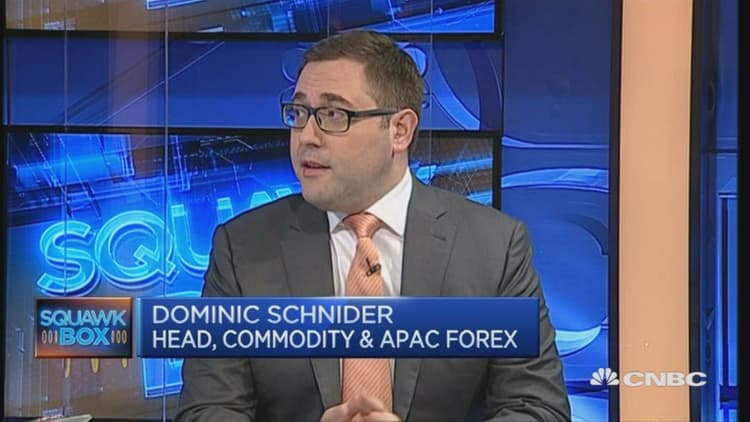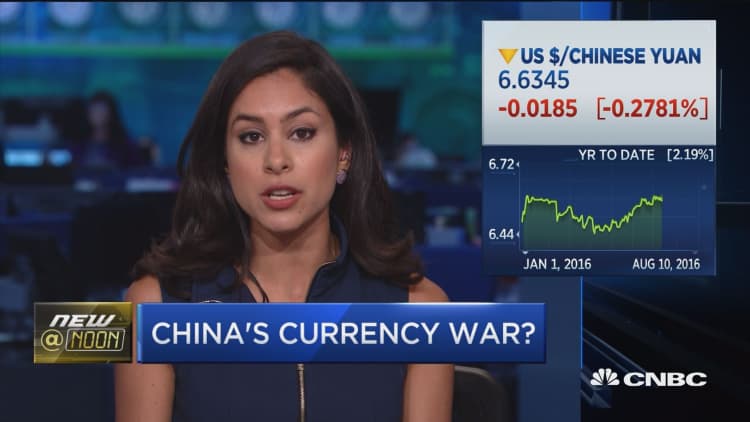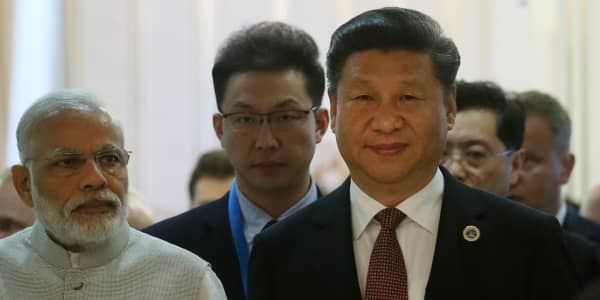
A year ago, China rattled markets from Mexico City to Mumbai as a tweak to its currency policy sent the yuan tumbling.
One year later, the renminbi, as the currency is also known, appears set to slide, but markets aren't taking fright.
On August 11, 2015, China shifted the market mechanism for setting the yuan's daily fix against the dollar, saying it would set based on the previous day's close, theoretically allowing market forces to play a greater role in its direction. China's policy makers allow the yuan to move within a 2 percent band around the daily fix and fixings in the past had been a bit more arbitrary.
The central bank also set the reference rate 1.9 percent below the previous day's fix, marking the steepest one-day decline in at least 20 years. The move revived concerns over the health of China's economy, the world's second-largest, and sparked fears of a "currency war."
Chinese equities, which had already tumbled amid excessive margin buying, plummeted further and dragged most other risky assets along with them.
"The world went into this crazy panic about it, which was quite extraordinary because we'd watched the yen and the euro depreciate quite rapidly in 2014 and people came out with all these theories about why China was much more significant," Adrian Mowat, chief Asian and emerging market equity strategist at JPMorgan, told CNBC's "Squawk Box" on Monday.
"Now, I think we've got much more mature currency markets and they recognize the fact that renminbi, like every other currency, should move up and down and we shouldn't be overly dramatic about the impact of it," he said.
Mowat expected that after the currency's around 7 percent decline over the past year, it likely has another 1-2 percent more to go this year.
The new policy on the fix wasn't the only change for the renminbi. In December, China introduced a new exchange rate index that valued the yuan against a basket of 13 trade-weighted currencies, which was read at the time as the country preparing for a as the U.S. Federal Reserve began hiking interest rates.
Analysts said at the time that by focusing attention on the currency's value against a broader range of currencies, China should be able to allow the yuan to gradually fall against the dollar without sparking market unease.
But it still set off yet another round of fund outflows from the mainland. Capital outflows, which had picked up after the stock market tumble and the hefty devaluation, continued after the introduction of the index.
China suffered almost $700 billion worth of capital flight in 2015, according to the Institute of International Finance.
Beijing logged $100 billion per month in average currency outflow during November, December and January but the pace of outflows had tapered off in more recent months, with net foreign exchange sales by commercial banks at $23.7 billion in April, down from $36.4 billion in March, Reuters reported.
The surge in outflows late in 2015 sparked market concerns that China's foreign reserves weren't sufficient to stabilize the currency. In July, reserves fell to $3.20 trillion, off a peak of $3.99 trillion in June 2014, according to Reuters. The decline over the previous month was however, more modest at $4.10 billion. China's foreign reserves had fallen by a record $513 billion last year, according to Reuters.
There have been some clear changes to how the yuan trades since the policy adjustment that have provided a semblance of stability.
Volatility has also ebbed somewhat due to efforts by the central bank to discourage speculators from betting on further declines in the yuan, particularly in Hong Kong, the hub for trading offshore yuan.
For instance, the central bank aggressively purchased yuan in Hong Kong earlier this year to reduce the amount of spare renminbi in the banking system, effectively making it more expensive to borrow the currency.
The currency has begun to track broader dollar movements better than prior to the fixing reform last year, noted Patrick Bennett, a strategist at CIBC Capital Markets. But analysts had noted that the fixing didn't always closely track the currency basket.

"That type of market movement has been sought and is welcome by monetary authorities, even if there is still a degree of disbelief at the transparency of the fixing process," Bennett said in a note last week.
He noted that People's Bank of China (PBOC) official have said they would keep the exchange rate "basically stable" at an equilibrium level, but "that doesn't say in equilibrium with what, and we firmly believe the yuan will depreciate further in coming months as China continues its push to export more capital and more product."
Others were less concerned with the yuan's weakness than in how the policy changes affected the market's view of Chinese policy makers.
The yuan may have weakened amid the policy turmoil, but that hasn't affected China's economy much, Julian Evans-Pritchard and Chang Liu, economists at Capital Economics, said in a note last week.
"There were few signs a year ago that a strong renminbi had been undermining Chinese competitiveness," the economists noted. Since then, the weaker yuan hasn't stoked inflation and any gains in export competitiveness were small compared with other emerging market currencies, they noted.
But the two added that the launch of the new policy was "botched," leaving open the risk of further blunders ahead.
"In both cases, it was the markets' distrust of the PBOC's intentions rather than the changes themselves which caused depreciation pressure to surge," the duo said. "A year on, investors appear slightly more relaxed about movements in the renminbi, but we suspect that they remain as wary as ever about trusting Chinese policymakers to keep their word."
Follow CNBC International on Twitter and Facebook.
—By CNBC.Com's Leslie Shaffer; Follow her on Twitter @LeslieShaffer1





